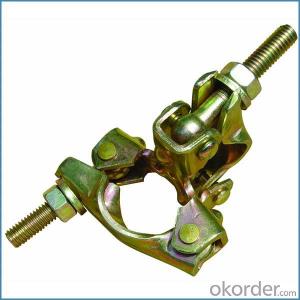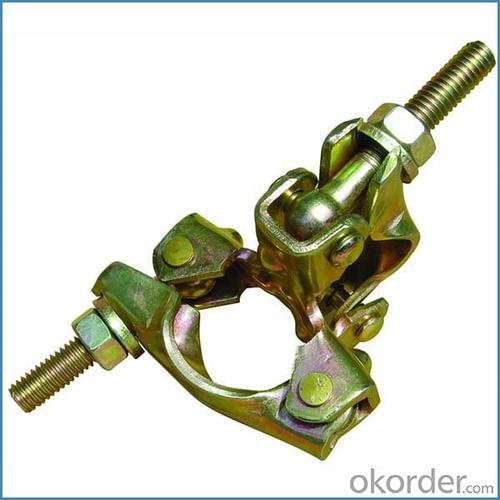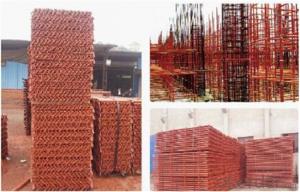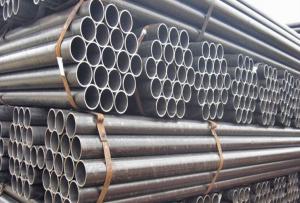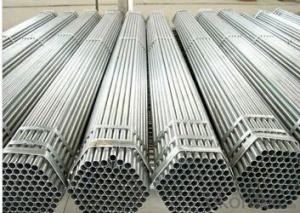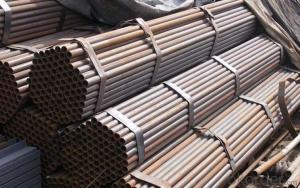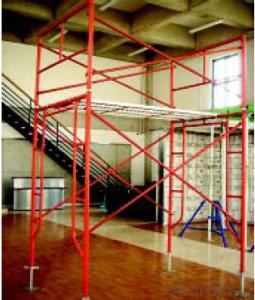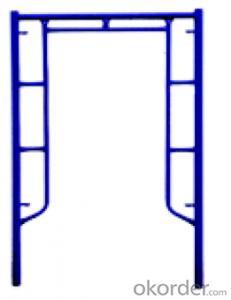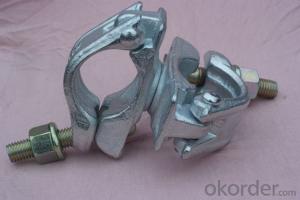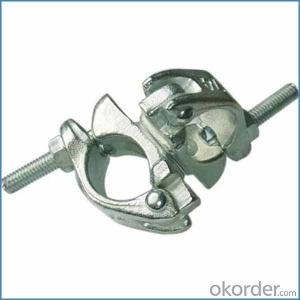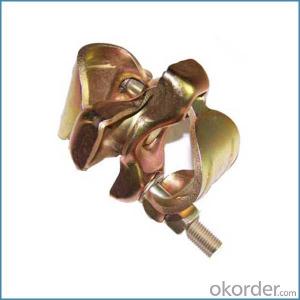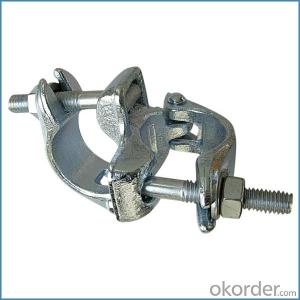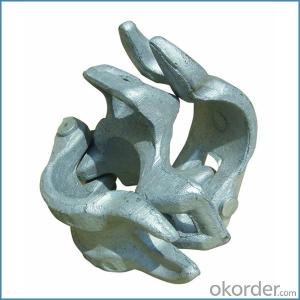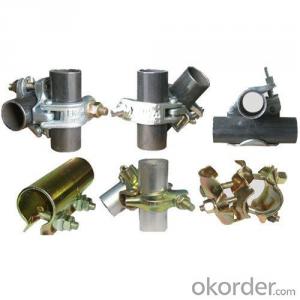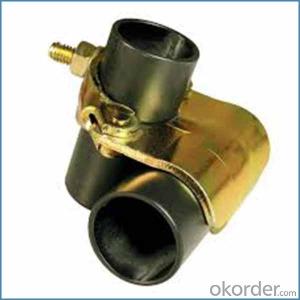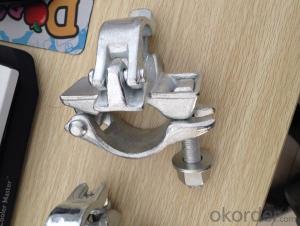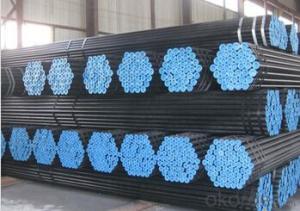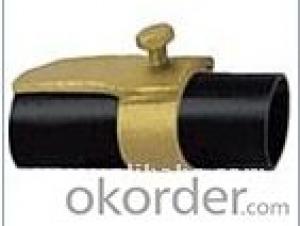Scaffolding Tube Clamp british German Forged Type
- Loading Port:
- Tianjin
- Payment Terms:
- TT OR LC
- Min Order Qty:
- 1000 kg
- Supply Capability:
- 100000 kg/month
OKorder Service Pledge
OKorder Financial Service
You Might Also Like
Scaffolding Tube Clamp british German Forged Type
Description
1.The scaffolding coupler is always used to connect the steel pipe as scaffolding system.
2.The often used coupler is swivel coupler and righ angle coupler .
3.We can provide types of scaffolding coupler according to your requirement.
4.Couoler can fix the 48.3mm scaffolding steel pipe tightly and make the whole scaffolding system more steadily.
Feature
(1)Excellent Anti-Breaking—Cold Pressed Steel
(2)Outstanding Resistance Deformation
(3)Strong Anti-Dropping Ability
Photo
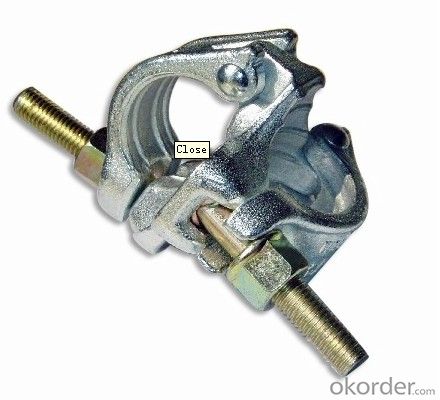
Parameter
| Material | Q235,345steel |
| Size | 48.3mm*48.3mm |
| Surface finish | Galvanized |
| Weight | 1.1kg around |
| Standard | BS1139,EN74 |
| Package | 25pcs/bag,steel pallet |
| Manufacture | As per customer requirement |
| Market | Africa, South America, the Middle East and Asia |
FAQ
Q: Are you a factory or trading company?
We are a state-owned corporation in China,dealing with various kinds of building materials.We have our holding subsidiaries.
Q: Where is your factory located? How can I visit there?
Our factory is located all around China.
Q: Can I get some samples?
Sample is free, customer only pay freight for the first time.
Q: Delivery?
10-30days. (5-15 containers)
Any question,feel free to contact us.
- Q: How long can steel tube couplers last in scaffolding applications?
- Steel tube couplers can last for several years in scaffolding applications, provided they are properly maintained, inspected regularly, and used within their recommended load capacities. However, the exact lifespan of couplers can vary depending on factors such as the quality of the couplers, the environmental conditions they are exposed to, and the frequency and intensity of their usage.
- Q: How do steel tube couplers affect the overall stability and strength of scaffolding structures?
- Steel tube couplers play a crucial role in enhancing the overall stability and strength of scaffolding structures. These couplers are the connectors that hold the steel tubes together, forming a rigid and secure framework. Firstly, steel tube couplers ensure the structural integrity of scaffolding by providing a reliable connection between the tubes. When properly installed, they eliminate any potential movement or slippage between the tubes, thus preventing the scaffold from collapsing or becoming unstable. This is particularly important in ensuring the safety of workers who rely on the scaffold for support while performing tasks at height. Moreover, steel tube couplers distribute the load evenly across the scaffold structure. When weight is applied to the scaffold, whether it be the workers, equipment, or construction materials, the load is transferred through the steel tubes. The couplers effectively transfer this load from one tube to another, minimizing stress concentrations and preventing any weak points from forming. As a result, the scaffolding structure remains stable and can withstand heavy loads without compromising its strength. In addition, steel tube couplers allow for flexibility in scaffolding design and construction. They enable the assembly and disassembly of scaffolding systems quickly and easily, allowing for efficient transportation and movement of the scaffolding to different locations. This flexibility is vital in construction projects where the scaffold needs to be adjusted or extended to accommodate varying work requirements or changing site conditions. The ability to connect and disconnect tubes using couplers makes scaffolding structures versatile and adaptable. Overall, steel tube couplers significantly contribute to the stability and strength of scaffolding structures. They ensure a secure connection between tubes, distribute loads evenly, and provide flexibility in design and construction. By incorporating high-quality steel tube couplers, construction companies can enhance safety, efficiency, and durability in their scaffolding operations.
- Q: Are steel tube couplers compatible with different types of scaffolding systems?
- Yes, steel tube couplers are compatible with different types of scaffolding systems. They are designed to securely connect steel tubes used in scaffolding, regardless of the specific type or brand of the scaffolding system.
- Q: Are there any specific safety guidelines for using steel tube couplers in scaffolding?
- Yes, there are specific safety guidelines for using steel tube couplers in scaffolding. Firstly, it is important to ensure that the couplers used are of high quality and meet the required standards. They should be properly manufactured and fit for purpose. It is recommended to use couplers that have been tested and approved by relevant authorities or organizations. Secondly, it is crucial to inspect the couplers before use. This includes checking for any signs of damage, wear, or corrosion. If any defects are found, the couplers should be replaced immediately. Additionally, it is essential to properly secure the couplers to the scaffold tubes. This can be done by fully tightening the bolts or clamps as per the manufacturer's instructions. Loose or improperly secured couplers can result in instability and pose a safety risk. Furthermore, when erecting scaffolding with steel tube couplers, it is important to follow the manufacturer's guidelines and industry best practices. This includes ensuring that the scaffold is properly braced, level, and plumb, and that the correct number and type of couplers are used to provide adequate support and stability. Regular inspections and maintenance of the couplers and scaffolding are also necessary to ensure ongoing safety. This includes checking for any signs of damage, wear, or movement, and addressing any issues promptly. In summary, specific safety guidelines for using steel tube couplers in scaffolding include using high-quality couplers, inspecting them before use, properly securing them to scaffold tubes, following manufacturer's guidelines, conducting regular inspections and maintenance, and adhering to industry best practices. By following these guidelines, the risk of accidents or failures can be minimized, ensuring a safe working environment for those using the scaffolding.
- Q: What is a steel tube coupler in scaffolding?
- A steel tube coupler in scaffolding is a device that is used to connect two steel tubes together in order to create a stable and secure scaffolding structure. It is typically made of high-quality steel and is designed to withstand heavy loads and provide a reliable connection between the tubes. The coupler is usually in the shape of a clamp or a sleeve, with bolts or pins that can be tightened to ensure a tight and secure fit. It is an essential component in scaffolding construction as it allows for the assembly and disassembly of scaffolding structures in a safe and efficient manner.
- Q: Fastener scaffolding to the top of the top step What does this mean?
- Not necessarily. If you pour with the floor, you can use the structure of the stairs. If the masonry wall, you can take a straight ladder.
- Q: What are the typical safety certifications for steel tube couplers?
- The typical safety certifications for steel tube couplers include the International Organization for Standardization (ISO) 9001 certification for quality management systems, the Occupational Safety and Health Administration (OSHA) certification for workplace safety, and the American National Standards Institute (ANSI) certification for product performance and safety standards.
- Q: Do steel tube couplers require any specific training for installation and usage?
- Installation and usage of steel tube couplers necessitate specific training. Although they may appear easy to use, it is crucial to receive proper training to guarantee accurate installation and safe utilization. To comprehend the appropriate procedures for installing steel tube couplers, including alignment, tightening, and torque requirements, training is imperative. Incorrect installation may result in coupler failure or inadequate performance, posing a safety hazard. Furthermore, training is essential to grasp the limitations and load capacities of steel tube couplers. They are engineered to withstand specific loads, and surpassing these limits can lead to structural malfunction. Adequate training will provide the knowledge required to select the suitable size and type of coupler for a given application. Moreover, training will encompass inspection and maintenance prerequisites for steel tube couplers. Regular inspections are critical to identify any indications of wear, damage, or corrosion that could compromise the integrity of the couplers. Proper maintenance, including lubrication and cleaning, will extend the lifespan of the couplers and ensure their continued performance. In conclusion, even though steel tube couplers may seem uncomplicated, specific training is necessary for correct installation and usage. Investing in proper training will guarantee the secure installation, correct utilization, and appropriate maintenance of the couplers, ultimately minimizing the risk of accidents and maximizing their performance and longevity.
- Q: How do steel tube couplers accommodate different tube sizes or dimensions in scaffolding systems with non-standard or custom profiles?
- Scaffolding systems utilize steel tube couplers to accommodate a range of tube sizes or dimensions, including non-standard or custom profiles. These couplers possess the ability to be adjusted by tightening or loosening the bolts or screws that secure them in position, thereby ensuring a versatile fit for various tube sizes. Among the common types of steel tube couplers is the swivel coupler, composed of two clamps connected by a swivel mechanism. This design enables the coupler to rotate and adapt to different angles. By utilizing bolts or screws, the clamps tightly fasten to the tubes, creating a robust and stable connection. In situations where non-standard or custom profiles are involved, which may deviate from the standard scaffolding tubes in shape or dimensions, specialized couplers are often employed. These couplers are specifically engineered to accommodate the unique shape or size of the tubes. They may include adjustable clamps or additional features to guarantee a secure fit. Furthermore, certain steel tube couplers are equipped with adjustable collars or sleeves that can be shifted along the length of the tube to accommodate varying dimensions. These collars can be securely tightened to ensure the tube remains in place, regardless of its size or profile. In essence, steel tube couplers are designed to possess versatility and adaptability for different tube sizes or dimensions in scaffolding systems. Whether it involves a standard tube or a non-standard/custom profile, these couplers can be adjusted, tightened, or modified to establish a strong and secure connection, consequently ensuring the safety and stability of the scaffolding structure.
- Q: Do steel tube couplers require regular maintenance?
- Steel tube couplers do not typically require regular maintenance. They are designed to be durable and reliable, capable of withstanding high loads and harsh environmental conditions. However, it is important to inspect them periodically to ensure they remain in good working condition. This includes checking for any signs of wear, corrosion, or damage that may have occurred over time. If any issues are found, appropriate maintenance or repairs should be carried out to prevent further damage or potential failure. Overall, while steel tube couplers are generally low-maintenance, regular inspections are recommended to ensure their continued performance and safety.
Send your message to us
Scaffolding Tube Clamp british German Forged Type
- Loading Port:
- Tianjin
- Payment Terms:
- TT OR LC
- Min Order Qty:
- 1000 kg
- Supply Capability:
- 100000 kg/month
OKorder Service Pledge
OKorder Financial Service
Similar products
Hot products
Hot Searches
Related keywords
